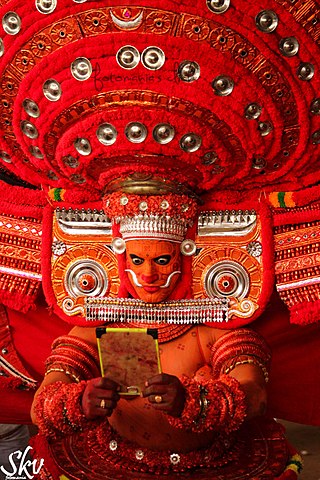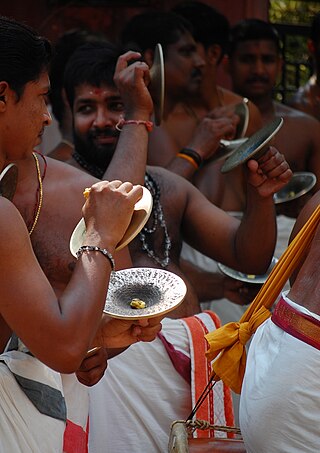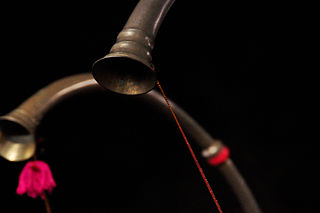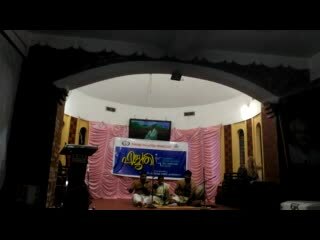
Carnatic music, known as Karnāṭaka saṃgīta or Karnāṭaka saṅgītam in the South Indian languages, is a system of music commonly associated with South India, including the modern Indian states of Karnataka, Andhra Pradesh, Telangana, Kerala and Tamil Nadu, and Sri Lanka. It is one of two main subgenres of Indian classical music that evolved from ancient Hindu texts and traditions, particularly the Samaveda. The other subgenre being Hindustani music, which emerged as a distinct form because of Persian or Islamic influences from Northern India. The main emphasis in Carnatic music is on vocal music; most compositions are written to be sung, and even when played on instruments, they are meant to be performed in gāyaki (singing) style.

Qawwali is a form of Sufi Islamic devotional singing, originating in the Indian subcontinent.

Yakshagana is a traditional theatre, developed in Dakshina Kannada, Udupi, Uttara Kannada, Shimoga and western parts of Chikmagalur districts, in the state of Karnataka and in Kasaragod district in Kerala that combines dance, music, dialogue, costume, make-up, and stage techniques with a unique style and form. It is believed to have evolved from pre-classical music and theatre during the period of the Bhakti movement. It is sometimes simply called "Aata" or āṭa. This theatre style is mainly found in coastal regions of Karnataka in various forms. Towards the south from Dakshina Kannada to Kasaragod of Tulu Nadu region, the form of Yakshagana is called Thenku thittu and towards the north from Udupi up to Uttara Kannada it is called Badaga thittu. Both of these forms are equally played all over the region.(Not sure about this one but) Yakshagana is traditionally presented from dusk to dawn. Its stories are drawn from Ramayana, Mahabharata, Bhagavata and other epics from both Hindu and Jain and other ancient Indic traditions.

The music of Kerala has a long and rich history. It is not the same as Malayalam poetry, although most of it is poetry driven. Kerala has a rich tradition in Carnatic music. Songs formed a major part of early Malayalam literature, which traces its origin to the 9th century CE. The significance of music in the culture of Kerala can be established just by the fact that in Malayalam language, musical poetry was developed long before prose. With the development of music in the region, different branches were formed out of it.

Theyyam are Hindu ritual practiced in northern Kerala and some parts of Karnataka. Theyyam is also known as Kaḷiyāṭṭaṁ or Tiṟa. Theyyam consists of traditions, rituals and customs associated with temples and sacred groves of Malabar. The people of the region consider Theyyam itself as a channel to a god and they thus seek blessings from Theyyam.

Velakali is a traditional martial dance of Nair community of Kerala, India that is performed during temple festivals. Brightly dressed dancers wielding swords and shields depict a fight sequence between the Pandavas and Kauravas during the course of the dance.

The kuzhal is a traditional double reed wind instrument used in the south Indian state of Kerala. It is similar in construction to a nagaswaram or a large shehnai, and has a very shrill and penetrating tone.

Pandi melam is a classical percussion concert or melam (ensemble) led by the ethnic Kerala instrument called the chenda and accompanied by ilathalam (cymbals), kuzhal and Kombu.

Panchari Melam is a percussion ensemble, performed during temple festivals in Kerala, India. Panchari Melam, is one of the major forms of Chenda Melam, and is the best-known and most popular in the kshetram vadyam genre. Panchari Melam, comprising instruments like Chenda, Ilathalam, Kombu and Kuzhal, is performed during many temple festivals in central Kerala, where it is presented in arguably the most classical manner. Panchari is also traditionally performed, albeit with a touch of subtle regional difference, in north Kerala (Malabar) and south-central Kerala (Kochi). Of late, its charm has led to its performance even in temples in Kerala's deep south.
Thayambaka or tayambaka is a type of solo chenda performance that developed in the south Indian state of Kerala, in which the main player at the centre improvises rhythmically on the beats of half-a-dozen or a few more chenda and ilathalam players around.

Elathalam, or Ilathalam, is a metallic musical instrument which resembles a miniature pair of cymbals. This instrument from Kerala in southern India is completely made out of bronze and has two pieces in it.

The Kombu or Kompu also known as the Kombu Pattu is a wind instrument in Tamil nadu and Kerala. Usually played along with Panchavadyam, Pandi Melam, Panchari melam etc. This musical instrument is usually seen in south India. The instrument is like a long horn.

The culture of Kerala has developed over the past millennia, influences from other parts of India and abroad. It is defined by its antiquity and the organic continuity sustained by the Malayali people. Modern Kerala society took shape owing to migrations from different parts of India and abroad throughout Classical Antiquity.
Uthramvilakku is a temple festival celebrated at Edakkunni in Ollur, south of Thrissur in central Kerala, south India. The highlight of the event is an over four-hour Panchari melam in the temple compound past midnight on the uthram day, with each of the five caparisoned elephants on the occasion carrying a deity each from as many temples.
Konni is a town and a Taluk headquarters in Pathanamthitta district, Kerala, India. Konni is known for its elephant cages, forests, and rubber plantations. Konni is also known as "Anakoodinte Nadu".Nearest City is Pathanamthitta.Konni Is Located 32 km Distance from Chengannur railway station.Well Connected Via Muvattupuzha- Punalur Highway.Buses Ply Frequently From Pathanamthitta KSRTC Bus Station To Konni.

Pulluvan Pattu is a form of serpent worship performed by both the lower castes and higher castes, in addition to serpent temples. The pulluvar of Kerala are closely connected to serpents. They consider the snake gods their presiding deities and perform sacrifices and sing songs.

Villu Paatu, also known as Villadichampaatu, is an ancient form of musical story-telling method performed in Southern India, where narration is interspersed with music, an art of southern states of Tamil Nadu and Kerala, as well as North-East Sri Lanka. This art form is popular among Nadar and Ezhava castes of erstwhile Travancore kingdom. Simple tunes and verses make the story easy to follow. The villu (bow), the age-old weapon of warriors - paradoxically lends itself to be used as a primary musical instrument for the Villu Paatu artists.
Kshetram vadyam is the ritual music of South India. This is the main traditional music of Kerala state. It is a percussion dominated music.

Kalampattu is a traditional performing art in Kerala, India.

The Udukku, also known as Udukkai, is an Indian traditional percussion instrument of South Indian, popular in Kerala, Tamil Nadu and north and east parts of Sri Lanka. It is similar to Damaru and Edakka, larger than the former but smaller than the latter.















